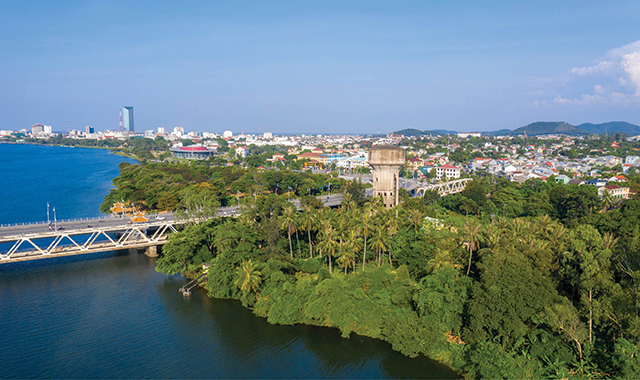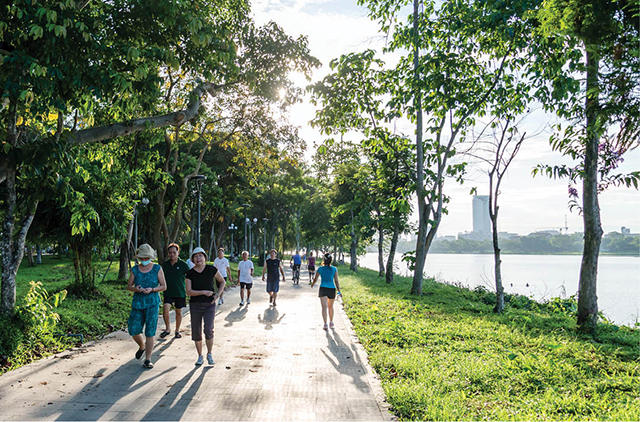After 26 years in Bac Vong, once again in 1738, the Nguyen Lord’s residence was moved back to Phu Xuan in Lord Nguyen Phuc Khoat’s era. Then after the unification of Vietnam, Phu Xuan became the imperial capital city of the Nguyen Dynasty. Kim Long and Phu Xuan were famous villages by the Perfume River.

The two sides of the Perfume River have been embellished toward a green, clean and bright city. Photo: Thanh Toan
This is what Emperor Minh Mang said to his men as recorded in Dai Nam Thuc Luc: “The river in Gia Dinh is winding; the plain in Bac Thanh is so flat without reliable places. The landscape of Binh Dinh is good, but too narrow; Quang Nam, Quang Binh and Thanh Hoa are not suitable places for the capital. In a word, no place is better than Phu Xuan with its bright sandy landscape and calm rivers and mountains...”
The calm river is the Perfume River. I think the Nguyen Lords and Nguyen Kings were so tempted by the legendary river of Perfume that they moved their residences to Kim Long and Phu Xuan and finally chose it to be the capital city.
As the legend goes, when Lord Nguyen Hoang came to Thuan Hoa, he himself surveyed its landscape. Once he was roaming along the Perfume River, he spotted a small hill named Ha Khe with its shape looking like a dragon with its head turning back.
Local people said that every night, there appeared an old lady in red and green on the hill saying that there would be a lord who would come here to set up a pagoda to gather the energy of the universe and to protect the geomantic vein for a powerful country.
Lord Nguyen Hoang’s thinking happened to coincide with people’s expectations. Gladly, in 1601, he had a pagoda built on the hill facing the Perfume River and named it Thien Mu (Heavenly Lady.)
2. Currently Hue City has 24 wards and communes, most of which lie along the Perfume River. At the source of the river are Thuy Bieu and Huong Long and further down are Vy Da and Phu Hau. Hue City will be expanded to include Thuy Bang and Huong Tho at the fork of Tuan, and Thuan An and Hai Duong where the river meets the sea.

The green and shady walking street along the Perfume River. Photo: Dang Tuyen
Many well-known cities in the world are connected with beautiful rivers. In Europe there are St. Petersburg (Russia) with beautiful Neva River, Paris (France) with Seine River and London (England) with pretty and peaceful Thames River creating a landscape too romantic to describe.
Not far away from Hue is Bangkok (Thailand), a bustling city with many ancient temples and pagodas. Across the city is Chao Phraya River running from the north to the Gulf of Thailand.
But rare is the closeness of Hue City and the Perfume River. It not only runs through the city like the Neva with St. Peterburg, the Seine with Paris, the Thames with London, or the Chao Phraya with Bangkok, the whole river of Perfume belongs to Hue City from west to east. The Perfume River gives Hue City unique nuances, from majestic and mighty to taciturn and superb, to gentle and attractive, then immense when river waves mingle with sea waves.
3. At Hue Festival 2008, for the first time, a special program named "Legend of the Perfume River" was held, bringing visitors back to an ancient space imbued with traditional cultural beauty and memories for a golden imperial court, from Bang Lang Fork to Nghinh Luong Dinh in front of Phu Van Lau. Leaving the wharf at Minh Mang Mausoleum at purple sunset, the King’s Boat and the 20 accompanying dragon boats took visitors on a cruise on the Perfume River. The nearly 15-kilometer-long river served as a giant stage.
Also on this legendary river, the new program “Who Named the River” will be launched at Hue Festival 2020 at Nghinh Luong Dinh on August 8th, 2020. This is an art program inspired from historical stories about the poetic river. It will again reveal the mysteries of Hue and of the river of Perfume, promising many nice surprises.
That reminds me of the writing with the same title by Hoang Phu Ngoc Tuong, praising the Perfume River as a symbol of Hue. It is considered one of the most beautiful, concise and poetic pieces about the Perfume River.
People are talking a lot about Hue City being expanded 5 times as large with many dreams and intentions. As for me, it is the last step to complete Hue and the river of Perfume.
The river is 100km long and its middle part is the 33-kilometer-long Perfume River that runs from Bang Lang Fork to Thuan An, which is Hue. The river flow is so slow and peaceful as described by Thu Bon “Con song dung dang con song khong chay/ Song chay vao long nen Hue rat sau.” (“The river hesitates; the river does not flow/ The river flows within; so Hue is deep.”)
The river of Perfume imbued with many triumphs and legends runs from west to east like a backbone dividing the city into North Bank and South Bank. For me, Hue is therefore the city of Perfume River.
By Dan Duy
